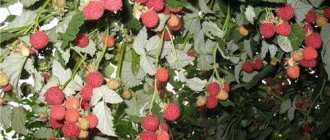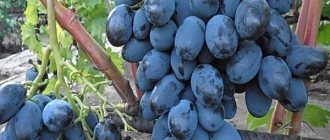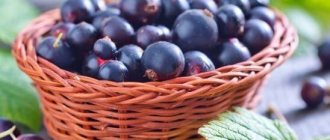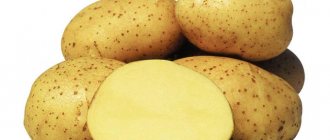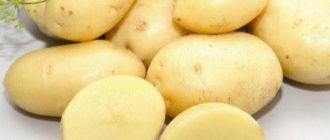Photo and description of the Giant raspberry
Raspberry Giant is a compact bush up to two meters high. The shoots of the plant are thick, straight, and devoid of thorns. During one growing season, the bush forms about 10 shoots and up to 6-7 root shoots.
The leaves of the plant are dark green, covered with dense pubescence on the outside. The bush blooms with white racemose inflorescences. After flowering, large conical berries are formed in the clusters, painted in a dark ruby color. The weight of the fruit reaches 15-25 grams. The taste of the berries is sweet and sour.
Description of the variety
Bushes with large and tasty berries attract the attention of experienced gardeners and ordinary summer residents. The giant rightfully takes pride of place in the national ranking of popular raspberry varieties.
- A thornless compact bush of large-fruited raspberries is formed from powerful, erect shoots 160-180 cm high. Annual shoots are smooth, without a waxy coating. The outer cover of the shoots of the 2nd year of vegetation is gray-brown.
- Large dark green leaves with a ribbed surface are framed by a serrated edge.
You might be interested! Description of the most popular variety of raspberry trees - standard raspberry Tarusa.
- The variety blooms in the second half of June. Flowers are collected in brushes.
- The dark red berries of an elongated cone shape are striking in size - up to 4 cm in length, weight - up to 12 g. Small seeds are practically not noticeable in the juicy pulp with a sweet and sour taste. The aroma is weak.
- The berries are easily separated from the stalk and do not fall off when harvesting is late.
- During the growing season, the bush produces 4-6 basal shoots (nettle) and up to 10 pcs. replacement shoots.
- Rosettes of flowers and fruits form on the upper part of the fruiting stem - each branch produces up to 15-30 berries.
Fruiting in Giant is extended, from early July to August. The berries are harvested in 5-6 stages - the yield of the bush is up to 5 kg.
Characteristics of the variety
The “progenitors” of the Giant variety are the large-fruited raspberries Stolichnaya and the low-growing Stambovaya-20. Breeders from the Moscow Research Institute of Horticulture managed to preserve the best qualities of these varieties and obtain a new hybrid suitable for cultivation in all regions of Russia.
Raspberry Ispolin is a remontant variety with a mid-season ripening period. The first berries of the variety can be enjoyed in early July. Fruiting lasts continuously until the end of August, and in some regions continues until the middle and even the end of September. The total yield of each bush is 5-6 kg. Under the most favorable conditions and proper care, the yield can increase to 8-9 kg.
Reference! The variety was bred specifically for regions with harsh climates, so it can tolerate frosts up to 30 degrees. The authors of the hybrid assumed the possibility of growing it in hot climates, so they also endowed the variety with resistance to drought.
History of the appearance of the variety
Raspberry Giant was bred by Russian breeders. In 1992, at the Institute of Horticulture under the leadership of V.V. Kichin, an experimental seedling was obtained from crossing the donor Shtambovy-20 and the Stolichny variety. Its characteristics - winter hardiness, high yield, medium height, large fruit - exceeded all the breeders' expectations, so it was decided to develop the plant into an independent variety. This happened in 1998. Thanks to its excellent qualities, the Giant raspberry received another name - the Pride of Russia.
Advantages and disadvantages
Raspberry Giant has earned many positive reviews from summer residents from all regions of Russia. Main advantages of the variety:
- high yield in any climatic conditions;
- resistance to diseases characteristic of the culture;
- long fruiting period;
- ease of reproduction;
- large size and transportability of berries;
- immunity to drought and high soil moisture.
Despite many advantages, the variety has some significant disadvantages:
- decrease in the taste of berries with a lack of sunlight and plenty of rain;
- increased demands on soil nutrition;
- crushing berries under prolonged exposure to high temperatures.
Advantages and disadvantages of Giant
Like all plants, the Giant raspberry variety also has its advantages and disadvantages.
Advantages of this variety:
- Large fruits and high yield.
- The berries have excellent taste and aroma.
- Since the bushes have a high shoot production rate, reproduction is not a problem.
- High frost resistance.
- Easy transportation of berries.
- Good resistance to many diseases.
Raspberries have good immunity to diseases.
Its disadvantages:
- The presence of double fruits due to poor environmental conditions.
- Easily reduces the sugar content of fruits in case of heavy rainfall and lack of sunlight.
- Needs increased nutrition.
- The amount of harvest depends on the quality of care.
- Requires shelter in extreme temperatures.
Planting and care
The optimal time for planting raspberry seedlings is the first ten days of October: at this time, the plants take root well, and they have time to prepare for wintering. However, the timing of planting should be adjusted based on the conditions of a particular region. There must be at least 16 days left before the first frost.
Raspberries prefer well-lit areas protected from the wind with a groundwater depth of no higher than 1.5 m. The soil for growing should be as nutritious and light as possible.
For planting, prepare holes 30x40 cm at a distance of 40 cm from each other, in a row of at least 1.5 m. Drainage is laid at the bottom of the holes, and fertile soil is placed on top.
Per square meter contribute:
- 6 kg of well-rotted horse or cow manure;
- 20 g potassium;
- 50 g superphosphate.
The seedling is placed in the hole without deepening the root collar. After planting, the plant is watered, using 4-5 liters of warm water. The surface is lightly compacted and mulched with peat or sawdust with a layer of 7–10 cm.
Advice! Before planting, the roots of the plant are soaked in a clay mash for 5-8 hours, then treated with an antibacterial drug and a growth stimulator.
Selection of Giant seedlings
The correct choice of planting material is of great importance. No one is protected from mistakes; it is difficult to discern varietal characteristics in a shoot, sometimes it is simply impossible. To protect yourself, follow these simple rules:
- Avoid shopping at spontaneous markets, near roads, or from random acquaintances. Instead of varietal plants, you can get wild shoots from a wasteland.
- Buy seedlings from large garden farms or shopping centers that have quality certificates for their products.
- As an exception, you can buy from a neighbor, after first examining the mother plant and making sure it belongs to the variety.
- Buy seedlings with unopened buds, without visible damage or new growths; it is better to prevent disease and parasite invasion than to treat it.
- The root system should be well developed, at least 15 cm long.
- Shoot length 45 cm.
Algorithm for planting planting material:
- Pour the nutrient mixture into the prepared hole and carefully place the plant, making sure that there are no upward kinks.
- Sprinkle with soil and compact the soil around, the root collar should remain at ground level.
- Pour 5 liters of water onto the bush and fill the resulting holes.
- Mulch with a layer of straw, hay, sawdust or peat at least 10 cm.
More on the topic: Cardinal raspberries
Planting pattern: distance between bushes 30-40 cm, between rows 1.5-2 meters.
Watering
High-quality, timely watering of raspberries is one of the main conditions for obtaining maximum yields. The bush should receive the main amount of moisture from the beginning of flowering until the end of fruiting.
The root system of this variety is powerful and deep-lying, so one bush uses 2-3 buckets of water when watering. The frequency of watering is 1 time per week, in dry periods - 2 times. On very hot days, the bushes are additionally irrigated with water over the foliage.
Important! In dry, hot autumn, raspberries need moisture-replenishing watering. If there is a lack of moisture in winter, the root system of the plant may freeze.
Agricultural technology of raspberry varieties Pride of Russia
Even the most hardy and completely undemanding varieties in terms of soil conditions, fertilizers and watering require basic care.
How to water correctly
During the first week after planting, the semi-shrub, in the absence of rain, must be watered daily (from 5 liters per bush). In the future, 10 liters per week is sufficient. In case of drought, the frequency of watering increases. Ideally, the soil under the bushes should never dry out.
Gardeners often use sprinkling; it is advisable to use it in the morning and evening so as not to cause burns on the leaves. True, this method can provoke the development of diseases that can progress quickly, at high air temperatures, with one drop of water.
The most win-win option is drip irrigation, constant uniform moisture, the absence of excess moisture on the leaves and significant water savings, which is very important in arid areas.
Fertilizer Giant
Raspberries always respond gratefully to feeding. Early in spring, as soon as the snow melts, add a bucket of rotted manure under each bush; you can fertilize it with chicken droppings or peat in combination with urea.
During the period of flowering and fruiting, complex fertilizing is better. In summer, the row spacing is covered with wood ash - 0.5 liters per 1 square meter.
After completing the fruiting period and pruning, you can also fertilize with manure (1-2 buckets per bush), and the fertilizer and roots are warmer in frosts.
Pruning raspberries Pride of Russia
In spring (March), young, healthy shoots are shortened to a healthy bud, old and diseased shoots are cut out at the root.
After the buds open, each stem is shortened by 10-15 cm; this procedure helps to increase fertility.
The third pruning is autumn, 2-3 weeks before frost, young and weak shoots are cut out, leaving about 10 strong replacement stems; in the spring their number will be reduced to 6-7.
Raspberry propagation Pride of Russia
There are several propagation options, but the fastest and easiest is by root shoots. In early spring (March) or autumn (September-October), carefully dig up the shoot, always with a clod of earth, and plant it in the prepared hole.
More on the topic: Indian Summer 2 raspberries
Enough root shoots are formed in “Giant” for rapid reproduction, both on your own site and on your neighbor’s.
Preparing the Giant for wintering
Despite its courageous name, the Pride of Russia raspberry can die in high frosts; it needs shelter for the winter. For this purpose, the bushes are tied together with ropes and pinned to the ground, then covered.
Many gardening stores offer special shelters for wintering shrubs.
Fertilizer
The variety is responsive to regular fertilizing with organic and mineral fertilizers. During the season, 3 feedings are carried out:
- In early spring - urea. The fertilizer contains a large amount of nitrogen, and after applying it, the bush begins to actively grow green mass.
- During flowering - with a phosphorus-potassium mixture.
- After harvesting, fertilize with superphosphate and additionally add wood ash between the rows.
Pests and their control
Raspberry Pride of Russia is susceptible to some pests.
Raspberry stem fly
Damages the tops of plants and, as a result, lack of fruits. You can collect it manually or destroy it with a fungicide, for example, Aktelik, but treatment is contraindicated during flowering.
Shoot gall midge
It hides near the surface of the soil and lays its larvae with the arrival of a warm period. A characteristic sign of its presence is cracking of the bark at the bottom of the bush.
It is impossible to save infected plants. The only means of control is to completely dig up and burn the raspberries; this will prevent the spread of the dangerous pest throughout the raspberry tree.
Raspberry beetle
His presence on the site is hard to miss. The parasite makes huge holes in the leaves and eats the entire ovary; it is capable of completely destroying the crop.
To prevent the spread of the pest, it is necessary to regularly weed or dig up the rows, carefully removing all weeds.
Chemical control measures: treatment with Aktelik fungicide before the first flowers appear.
Raspberry-strawberry weevil
Spray with Iskra-M before flowering, and after harvesting with Karbofos.
Trimming and tying
Raspberries are pruned 3 times per season. If the plant is allowed to form shoots and root shoots uncontrollably, the yield will decrease and the berries will begin to become smaller.
The pruning scheme and timing are as follows:
- The first is in the spring, in April or May, depending on the weather. At this time, weak, damaged and frozen shoots are completely removed from the bush, and strong, healthy shoots are shortened to the top bud.
- The second is after the buds have fully bloomed. The shoots are shortened by 10-15 cm. This technique stimulates the formation of lateral shoots, which increases the yield of the bush.
- The third is autumn, 2-2.5 weeks before a strong cold snap. Young shoots that have not yet formed during the season are cut off: if they are left on the bushes, they will freeze and provoke the proliferation of fungal diseases on the bushes. Old, fruit-bearing shoots are also cut out so that they do not thicken the bush.
The long stems that grow during the growing season are tied to a trellis. This provides access to the sun's rays to the fruits, promotes normal ventilation of the bush, and makes caring for the plant easier.
Care
Despite the fact that the Giant raspberry can easily tolerate dry periods, it loves moisture very much. For this reason, the plant must be watered abundantly and regularly, spending at least 4 buckets of water per bush.
The amount of moisture added depends on the growing season:
- May (beginning of the growing season) - 15–25 l/linear meter;
- July (beginning of fruiting) - 30–40 l/linear meter;
- August (second wave of fruiting) - 20–25 l/linear meter.
Important! It is advisable to carry out the last irrigation procedures in the first week of October: little water is consumed
-
5
-
10 liters.
At the same time, you can apply manure and cover the soil with mulch. The plant needs to be fed every year. Immediately after planting, a solution of manure , then, with the arrival of spring, nitrogen, superphosphate, rotted manure, and potassium salt . , ash and phosphorus-potassium complexes are added
No less important points in caring for Giant raspberries are gartering and pruning bushes. The garter is carried out either for each bush separately, or for all bushes to the trellis. The first option is usually used if the raspberry plant is small.
For large planting areas, it is best to give preference to the trellis method. The bushes are tied to a wire stretched along each row. The growth of the shoots of the Giant is intense, so the bush thickens quickly and needs to be thinned out from time to time.
Excess branches are trimmed three times per season:
- For the first time, weak, diseased, injured, dry, underdeveloped shoots are removed. All others are shortened to the top bud. These manipulations are carried out in early spring.
- The second time you can adjust the bush before buds open to increase the fertility of the crop. The stems are cut to 13–15 cm.
- The last time the plant is pruned is a couple of weeks before frost. Young, fragile shoots that are not able to survive frost are removed. In addition to them, old branches that thicken the bush and shoots that have bear fruit for two or more years in a row are removed.
Did you know? The division of raspberries into varieties began in the 16th century. During the same period, its cultivation began.
Loosening and mulching
Raspberry roots need access to oxygen, so the soil is freed from weeds and loosened. Loose soil creates optimal conditions for the development of beneficial bacteria.
After applying fertilizer, the space around the bush is mulched with a mixture of peat and rotted manure. Mulch helps prevent weed growth, allows roots to absorb fertilizer, and prevents moisture loss.
Features of cultivation
Caring for raspberries involves regular watering, weeding, and loosening the soil. You can use a drip irrigation system for plants. Watering is carried out at least once every 2 weeks. You should not water the bushes more often, since an excess of moisture can affect the taste characteristics of the fruit. After watering, loosening is done, and then the ground is mulched to prevent overheating of the roots.
The pride of Russia propagates well from cuttings. You can take apical layering or root suckers for propagation; the survival rate of the shoots is good and does not require additional preparation. If you do not plan to grow raspberries, then all young shoots are removed from the bush. Trim the shoots with pruning shears or a sharp knife. The cut areas must be cauterized with a pink solution of potassium permanganate so that the cut does not become infected and the bush does not get sick.
Wintering
The Gigantic variety easily tolerates frosts down to 25 degrees without additional shelter. It is enough to bend the shoots to the ground and sprinkle them with snow. In winter, additional snow is thrown into the raspberry tree (to protect the bush and provide the roots with moisture in the spring).
For your information! In regions with harsh winters, shoots are wrapped in non-woven agrofibre or covered with spruce branches for the winter. In the southern regions, additional preparation of raspberries for winter is not required.
How to breed a variety
At home, propagating raspberries is a procedure that does not require financial costs if you initially purchased a high-quality seedling of the Giant variety.
There are three methods of reproduction, the effectiveness of which has been tested in practice:
- root suckers;
- cuttings;
- dividing the bush.
Choosing any of the methods will allow you to increase your raspberry garden many times over.
Diseases and pests
The authors of the variety endowed it with disease resistance, but some problems still arise during cultivation, especially with care errors:
- Root cancer - rough bumps with a diameter of 2-3 cm appear on the leaves. The foliage gradually turns yellow and begins to fall off. The infected plant cannot be treated, so it is dug up and disposed of.
- Rust - the shoots are covered with gray ulcers, the leaves are covered with a dark coating on the bottom, brownish-red on the top. At the first signs of disease, the bush is sprayed with Bordeaux mixture.
- Septoria - brownish spots form on the leaves, gradually acquiring a white tint with a purple outline. Fungal spores are destroyed with the following copper-containing preparations: Hom, Oxyx, copper sulfate.
Weakened bushes are often attacked by insect pests:
- gall midge;
- aphid;
- bronze;
- weevil;
- mole.
To control pests, first remove the infected parts, then treat the bush with insecticides: Iskra, Inta Vir, Aktellik, Aktara, Karbofos.
Possible diseases of the raspberry variety Pride of Russia
The subshrub is quite resistant to a number of raspberry diseases and is rarely affected by aphids. But still, some diseases can defeat even a Giant. These include:
Root cancer is a tumor-like formation on the roots. The method of control is digging up and burning the diseased plant.
Rust - characteristic yellow-brown formations on the leaves and cankers on the stems. The control method is treatment with a 1% solution of Bordeaux mixture.
Bushiness - another name for sprouting - is formed from 30 to 200 thin, non-fruiting shoots. The method of control is to dig up and destroy; it cannot be treated.
Septoria - white spots with a purple border appear on the leaves and stems. The method of control is to remove and burn the affected areas; treat the plants with copper oxychloride for preventive purposes before buds open.
How to reproduce?
An old, heavily overgrown Giant bush can be dug up and divided into several parts. Before dividing the dug plant, the dried and oldest shoots are removed, and the remaining ones are shortened to 40 cm. Then the rhizome is divided into several parts and each is planted in a separate hole.
Young plants are propagated by root shoots and cuttings. When rooting cuttings, do the following:
- choose the thickest, semi-lignified shoot;
- cut it straight from the top, and obliquely from the bottom;
- planted in loose substrate to a depth of 5 cm.
Separating and planting a root shoot is the fastest way to get a new plant while preserving the main bush. The process consists of the following steps:
- The most viable and promising offspring are placed at a distance of 35-40 cm from the mother bush. The soil is carefully dug up so that the roots appear.
- To form new plantings, dig up 4-5 shoots. Select specimens with a large number of fibrous processes.
- The shoots are dug up along with the roots, trying not to damage them. If swellings are visible on the roots, it means that the plant is affected by gall midges. Such offspring cannot be planted.
- The top of the dug seedling is cut off; its height should be 20-25 cm. The leaves are also completely removed.
- The prepared offspring is treated with a growth stimulator and planted on the prepared area.
Important! Reproduction by root suckers is carried out in the spring, after the root suckers grow by 20-25 cm, or in the fall, 30-40 days before the onset of the first frost.
Landing
Raspberry fruiting occurs in 2 cycles. It will take one year for the shoots to form, and in the second year it will begin to actively bear fruit.
The plant begins to be planted in the spring, in March or in the fall at the beginning of October.
The most optimal time is autumn, since during this time the “Giant” will take root better and the soil will settle properly. Attention! Have time to plant no later than 14-16 days before frost. Plant raspberries in a place where sunlight “looks in” and the piercing wind does not enter. Soils, ideally, should be loamy, chernozem. "Giant" can also withstand acidic soils.
Reviews from experienced summer residents
Irina, Perm: Giant is one of the best varieties for our harsh region. I have 4 bushes of this variety growing at my dacha, and the harvest is enough for the whole family. The berries are large, the envy of the neighbors. Many people ask for shoots.
Konstantin, Krasnodar: Giant is my favorite raspberry. The harvest is excellent, there is enough for ourselves and there is some left for sale. The berries are large, tasty, always even and juicy. I advise everyone to plant this variety.
Valeria, Moscow region: The weather in our region is varied and sometimes unpredictable, but the Giant is not afraid of any climatic surprises. There are always plenty of berries, the main thing is to water and feed the bushes on time.
5 / 5 ( 2 voices)
Landing Features
Planting remontant raspberries of the Augustovskoe Miracle variety is not much different from planting ordinary raspberries.
Deadlines
In the northern regions, raspberries should be planted in the spring, before the buds open, so that by the beginning of winter the plant will take root well and take root. In the middle zone and in the south, it is permissible to plant seedlings in the fall, after the leaves have fallen, but no later than a month before the onset of frost. Plants with a closed root system can be planted in the summer, but such seedlings need to be properly cared for - shaded from the hot sun and watered, not allowing the soil to dry out.
Choosing a suitable location
Raspberries of the Augustovskoe Miracle variety are planted in a well-lit area. Lowlands with accumulation of cold air and precipitation and proximity to groundwater should be avoided. The latter should be no closer than one meter to the surface of the earth.
Important! It is better not to plant raspberry bushes next to or after blackberries. Nightshade crops are bad predecessors for raspberries.
Raspberries prefer loose fertile soils with a neutral or slightly acidic reaction (from 5.8 pH to 6.7 pH). Soils that are too acidic should be limed. It is recommended to apply humus, potassium and phosphorus fertilizers to the planting site in advance, or sow a potential raspberry garden with green manure.
Raspberries can be “returned” to the same place no earlier than after three years
Selection and preparation of planting material
It should be noted that you need to purchase seedlings from well-established sellers or specialized nurseries. When purchasing, you need to carefully examine the root system. It must be sufficiently developed and have a length of about 20 cm, and the cross-section of the root must be at least 5 mm.
Also find out why raspberry leaves turn yellow.
The roots should be free of damage and signs of rot or other diseases. If you cut off a bud from planting material, it should not be dried out. The bark will help make sure that the seedling is fresh - the inner layer should have a green color.
24 hours before planting, the root system of the planting material is placed in a solution with the addition of a growth stimulator - for better root formation
Planting scheme
The landing process occurs as follows:
- Dig holes measuring 0.4 × 0.4 m. An interval of 0.6–0.8 m is maintained between them. A distance of 1.5 m is maintained between rows.
- A mound of nutrient soil is poured into the hole, and a prepared seedling is placed on top of it.
- The roots are carefully straightened and covered with soil, leaving the root collar at ground level.
- The soil around the bush is well compacted.
- Watering is carried out (at the rate of 3 liters of water for each bush).
It is recommended to immediately mulch planted seedlings
Raspberry Giant, or a gigantic misunderstanding
Many people talk about him, and much does not correspond to reality. But the reality is this: the raspberry variety Ispolin, whose authorship allegedly belongs to V.V. Kichine, no. There is no description of it in scientific works published during the breeder’s lifetime, nor in the book Large-Fruited Raspberries of Russia, famous among raspberry growers, nor in the State Register of Varieties of Russia.
It is not found anywhere - except for superficial descriptions that apply to any variety of remontant raspberry.
Raspberry Giant and her double
In the photo there is supposedly a Giant raspberry, which is supposedly the Pride of Russia.
The raspberry variety Gigantic supposedly belongs to the hybrid fund of a talented breeder. During the life of Professor V.V. Kichina Giant remained a numbered form, an unnamed variety until the end of the 90s. After the death of the breeder, with the light hand of the co-authors, many varieties were registered.
This is how the variety Generalissimo and Paradise Delight, Divine - and our Giant appeared.
There is another version. According to the words of V.V.’s associates and friends. Kichin, Giant carries the genes of the Patricia and Tarusa varieties, and most of the forms “walking” across the expanses of Russia have nothing to do with it. As, in fact, to the Pride of Russia.
The common man has no opportunity to clarify the confusion around the scandalous variety. Misunderstanding or deliberate misrepresentation is the fuss around the Giant - there is no one to give an answer.
And there is no need. Everyone is happy: sellers sell seedlings, buyers buy. Gardeners are not interested in the name, but in productivity and taste. And - interest: what is this raspberry that everyone talks about, but few have seen?
Description of the variety, characteristics: each - a Giant
It’s hard to say what kind of variety is sold at VDNKh, spontaneous markets and in stores. But it’s worth taking a risk and bringing his description to a common denominator.
The raspberry variety Igor is remontant and bears fruit on the shoots of the current year. It begins to bear fruit from the first ten days of July. The fees are not extended - up to 6 main ones. The berries are produced until the first or second ten days of September.
- The bush is compact, shoots 1.7-2 m, not thorny. Young ones are green, with a waxy coating; by autumn they turn brown.
- The stems are flexible, not prone to bending, and bend down easily. Shoot formation is good - up to 12 shoots.
- Berries weigh up to 12-15 g, fruit branches bear 4-5 or more pieces. The color of the fruit when fully ripe is yellow-red, with a glossy finish.
- The shape of the berries is cone-shaped, elongated, regular. The berry is not lumpy, the drupes are well connected.
- The taste is good, sweet and sour, with a pronounced aroma and sufficient sugar content.
The disadvantages include the appearance of double berries, which is characteristic of large-fruited forms, low sugar content in the rain, and in cold summers.
Care and cultivation of the Giant
Caring for the variety is no different from other remontant forms. Growing in a one-year crop will be more productive: fruit-bearing shoots are cut down to ground level.
A gardener who has grown a single raspberry bush will not check the accuracy of the information. And so it is clear: raspberries, the maximum productivity of which varies within 3 kg, are not potatoes to yield 9-12 kg from 7-10 shoots.
Winter hardiness is moderate: in the northern regions, in cold winters in the Moscow region it requires bending down under the snow.
An attempt to give a reliable pomological description would be absurd. There is no way to compare the morphological characteristics of the giants walking around Russia.
Among the characteristics are the size, length of the sepals, and the shape of the berry, the color of the shoots and the shape of the leaf.
It is difficult to say what kind of reviews Raspberry Ispolin received, if the number of nameless forms under this pseudonym over the 18 years of his life is countless.
However, gardeners are most often satisfied: the berries are large, do not wrinkle, do not leak after picking, and the large ones are the envy of their neighbors.
In conclusion. And the berries keep growing - to gigantic sizes
V.V. himself Kichina, the author of a series of large-fruited hybrid forms, in the 80s characterized his best works much more modestly than their current descriptions sound. Thus, the weight of the largest fruits, with reference to the book Large-fruited raspberries of Russia, author's publications, is 6-12 g. With the dawn of raspberry commerce in Russia, the size of many berries increased to 16-18 g, and even up to 23 g. Yes, this is a berry the size of two matchboxes, not a raspberry, but a strawberry or a small apple. It's not funny, and it's sad. Why this lengthy afterword? Yes, just like that – as a private request: let’s not complicate each other’s already difficult life by misleading us with mythical descriptions of mythical varieties. There are a lot of raspberries - enough for everyone. And may it be sweet and the harvest good.
Growing Giant tomato
Cultivation of tomatoes of this variety in the ground is possible only in regions where there are a large number of sunny days. This condition is determined by the heat-loving nature of the plant and its requirements for light. Ideal places to grow Giant are the following areas:
- Belgorodskaya.
- Astrakhan.
- Voronezhskaya.
- Saratovskaya.
- Krasnodar region.
- Caucasus.
If you grow a tomato a little further north, then the variety can only grow in a greenhouse. Regulated heat supply and the possibility of increasing its concentration are excellent opportunities that are so necessary when growing this variety of tomatoes.
Sowing seeds for seedlings begins 65 - 70 days before the date of planting in open ground. When two leaves appear, the sprouts are picked. Planting in black soil is carried out in such a way that tall plants are not crowded.
A distance of at least 0.5 m should be maintained between seedlings, and the number of plants per 1 sq. m should not exceed four.
After planting in a greenhouse or open bed, caring for the Giants should be continued. It should consist of timely watering, removing shoots, eliminating weeds, and feeding plants with mineral fertilizer. To prevent the substrate from drying out, you can resort to mulching.
Giant raspberry is a variety that is resistant to pests and diseases, but preventive measures never hurt. It is necessary to maintain the level of soil and air humidity in the greenhouse, monitor the condition of the plants, and conduct a systematic preventive visual inspection of the plants for the appearance of unwanted “neighbors.” A black coating on the leaves should make you wary.
Raspberry picking and storage
When should you start picking raspberries? The ideal period is early July. As mentioned earlier, from one bush you can collect from 4 to 5 kg of raspberries. Despite the fact that this variety has dense pulp, raspberries are considered a delicate berry. It is easy to damage. Taking this into account, when harvesting, you should place the berries in a flat container or basket. The recommended layer is 12 or 15 cm, no more. If you follow these rules, you can transport raspberries without problems. She will endure it.
“Pride of Russia” is very tasty both fresh and canned. Raspberries are a universal berry that is suitable for making the following products:
You can even freeze the raspberries, puree them with sugar, or dry them. But in its fresh form, “Pride of Russia” will be stored for about three days.
High-yielding varieties
A gardener's dream is a raspberry plant that produces a large harvest all summer long. Thanks to the efforts of breeders, such varieties have already been bred. They are undemanding in care, with high, and most importantly, constant yield. Modern varieties are resistant to diseases and the vagaries of nature.
Find out also how to care for raspberries in autumn and spring.
Regular garden raspberries
Regular (summer) raspberries have a 2-year growing cycle. This year the stems are growing, and fruiting begins next season. The bushes grow upright, reach 200 cm in height. Frost-resistant, reproduce well. The berries are medium - about 3 g, the yield is low, about 2 kg per bush. Characterized by early ripening.
Large-fruited raspberry
Large-fruited raspberries have a high yield. The bushes are powerful, up to 180 cm, with thick stems. Berries, with proper care, can grow weighing up to 15–20 g. They are more tasty and juicy than conventional varieties.
Important! The location of the raspberry plant needs to be changed every 5–7 years
Standard raspberry
It cannot be confused with other species, because it is not a bush, but a tree. This is a new but very promising variety.
- Advantages of standard raspberries:
- landing takes up little space;
- does not require garter or support;
- high yield;
- The berries are large, with a dense structure, do not crumble when ripe and tolerate transportation well.
Remontant raspberry
These varieties bear fruit 2 times a year. There are varieties in which fruiting begins in June and continues until the onset of cold weather. They are noted for yields within 6 kg, but there are varieties with yields of more than 9 kg. The fruits are large, from 7 to 15 g. Remontant varieties are less susceptible to diseases and tolerate frosty winters better. Planting requires well-fertilized soil with neutral acidity.
